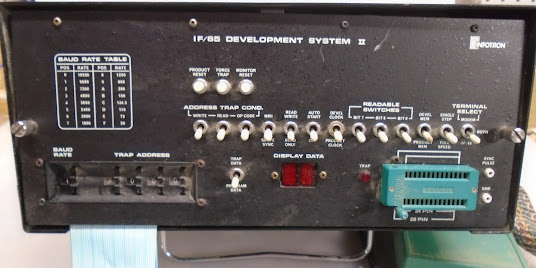The built in monitor software is accessed through a serial terminal. The monitor provides functions to read/write memory, test RAM, assemble and disassemble code, and access the EPROM programmer.
A really useful feature for troubleshooting was the address trap function. If, for example, you wanted to troubleshoot the address decoding hardware you would set the trap address to the address you were trying to test and then set the switches for read, write, and/or opcode access. Now any time that address is accessed you would get a sync pulse output through the connector on the lower right side. You would hook this signal to one channel of an oscilloscope and then use the other channel to probe the circuit and you would see what a signal state was as the moment the memory access was happening.
Another feature that comes in really handy for running test software is the ability of the 6502 code to access the serial ports on the IF65. This allows the test software to interact with the user even if the unit under test is totally non-functional. This functionality, when enabled, is accessed with the 6502 BRK instruction. The byte after the BRK command contains the command you want to execute and the Accumulator is used to pass data. For example, to print a character you would do this:
LDA #$30
BRK
.BYTE #$11



No comments:
Post a Comment